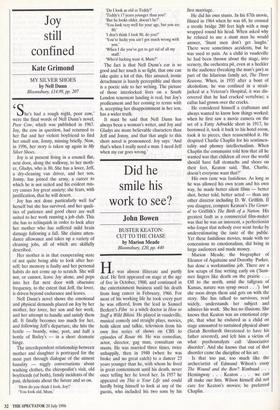Did he smile his work to see?
John Bowen
BUSTER KEATON: CUT TO THE CHASE by Marion Meade Bloomsbury, £20, pp. 440
He was almost illiterate and partly deaf. He first appeared on stage at the age of five in October, 1900, and continued in the entertainment business until his death from lung cancer in February, 1966. For most of his working life he took every part he was offered, from the lead in Samuel Beckett's Film to a witch doctor in How to Stuff a Wild Bikini. He played in vaudeville, musical comedy and straight plays, movies, both silent and talkie, television from his own live series of shows on CBS to episodes of Route 66. He was comedian, actor, director, gag man, consultant on stunts. He was married three times, twice unhappily, then in 1940 (when he was broke and no great catch) to a dancer 23 years younger than he, with whom he lived in great contentment until his death, never once telling her he loved her. In 1957 he appeared on This is Your Life and could hardly bring himself to look at any of the guests, who included his two sons by his
first marriage.
He did his own stunts. In his 87th movie, filmed in 1964 when he was 68, he crossed a trestle bridge 200 feet high with a map wrapped round his head. When asked why he refused to use a stunt man he would answer, 'Stunt men don't get laughs.' There were sometimes accidents, but he was used to pain. As a child in vaudeville he had been thrown about the stage, into scenery, the orchestra pit, even at a heckler in the audience (breaking the man's jaw) as part of the hilarious family act, The Three Keaton. When, in 1935 after a bout of alcoholism, he was confined in a strait- jacked at a Veteran's Hospital, it was dis- covered that he had cracked vertebrae; a callus had grown over the cracks.
He considered himself a craftsman and always wanted to know how things worked: when he first saw a movie camera on the set of a Fatty Arbuckle short in 1917, he borrowed it, took it back to his hotel room, took it to pieces, then reassembled it. He despised Charlie Chaplin for his sentimen- tality and phoney intellectualism. When Chaplin the communist told him that all he wanted was that children all over the world should have full stomachs and shoes on their feet, Keaton said, 'But, Charlie, doesn't everyone want that?'
His own taste was fastidious. As long as he was allowed his own team and his own way, he made better silent films — better shot, better told, better acted — than any other director including D. W. Griffith. If you disagree, compare Keaton's The Gener- al to Griffith's The Birth of a Nation. His greatest fault as a commercial film-maker was that he was an innocent, a perfectionist who forgot that nobody ever went broke by underestimating the taste of the public. Yet these fastidious movies, made with no concessions to emotionalism, did bring in large audiences and made money.
Marion Meade, the biographer of Eleanor of Aquitaine and Dorothy Parker, has done a workmanline job. There are a few scraps of fine writing early on ('Sum- mer lingers like death on the prairie . . . Off to the north, amid the tallgrass of Kansas, nature was syrup sweet . . .') but she soon drops them and gets on with the story. She has talked to survivors, read widely, understands her subject and admires his work. She has no illusions. She knows that Keaton was an emotional crip- ple, that what he endured as a child on stage amounted to sustained physical abuse (Sarah Bernhardt threatened to have his father arrested), and left him a victim of what psychoanalysts call 'dissociative disorder'. And she knows that out of that disorder came the discipline of his art.
Is that too pat, too much like the archer/artist of Edmund Wilson's essay The Wound and the Bow? Rimbaud . . • Hemingway . . . Keaton . . . we can all make our lists. Wilson himself did not care for Keaton's movies; he preferred Chaplin.


























































 Previous page
Previous page